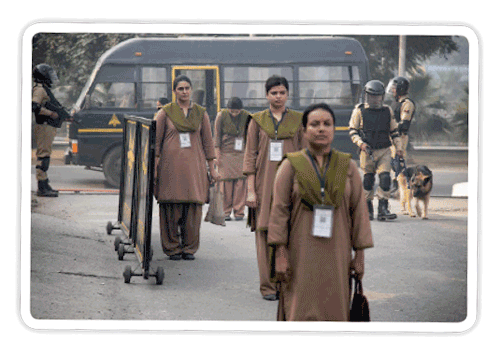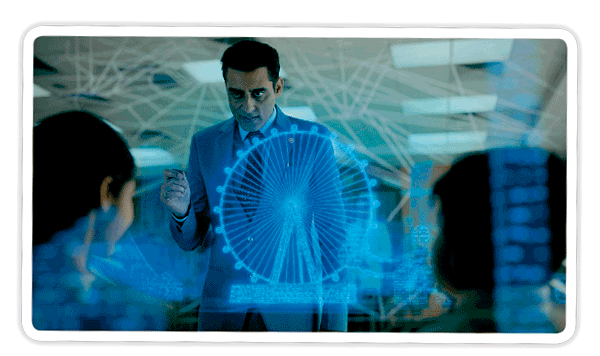Series Review: Leila
By Manal Khan | Television | Published 6 years ago
 When the widely followed anthology series Black Mirror failed to get the viewers’ attention Bandersnatch onwards, and after the acclaimed, The Handmaid’s Tale, based on Margaret Atwood’s book, started giving drag-the-storyline-for-more-views vibe, I stumbled upon Leila.
When the widely followed anthology series Black Mirror failed to get the viewers’ attention Bandersnatch onwards, and after the acclaimed, The Handmaid’s Tale, based on Margaret Atwood’s book, started giving drag-the-storyline-for-more-views vibe, I stumbled upon Leila.
The Netflix original Leila, directed by, Deepa Mehta, Shankar Raman and Pawan Kumar, is based on a dystopic novel of the same name by Prayaag Akbar. The show takes place in a post-apocalyptic India of 2047 which is now called Aryavarta, ruled by a fascist, Joshi, and runs on the principle of walls to segregate different classes of people on the basis of religion and wealth.
The main plot revolves around Shalini (Huma Qureshi), who has stolen water to fill up her swimming pool at a time when people outside of the walls have been thirsty for days. But this is not her only crime; she has also loved and married a Muslim man with whom she has a daughter of mixed ethnicity named Leila. For this, her brother-in-law, reports her to the authorities and in the first episode, all too quick, we see Leila being snatched away by the authorities, the husband being killed and Shalini being taken away to a women’s purity camp.
From the deep red saris the women in the purity camp wear, to the new-born children being separated from their mothers, sold into human trafficking and a woman killing herself because of trauma, Leila looks like an Indian version of The Handmaid’s Tale with an aura and cinematography that visually stuns you. For a political thriller, the sound design gives away a bit too much, before it actually happens, and yet engages you to know more.
 Initially, Shalini tries to be an obedient learner at the extremely violent re-education camp so she can soon qualify as a ‘pure’ woman, and reunite with her daughter. The purity camp run by Gura Ma (Arif Zakariya) and his right hand transwomen is a terrifying place that casually calls the ‘sinner’ women ‘sluts.’ The vocabulary seems to be appropriated from the dictionary of men, and with the power vested in the trans-women, the reinforcement of these ideals seem jarring. In the real world, transwomen are perceived to be involved in sex-work and shamed for it. This role reversal might have been subversive but sadly, it wasn’t explored much beyond the introductory episodes.
Initially, Shalini tries to be an obedient learner at the extremely violent re-education camp so she can soon qualify as a ‘pure’ woman, and reunite with her daughter. The purity camp run by Gura Ma (Arif Zakariya) and his right hand transwomen is a terrifying place that casually calls the ‘sinner’ women ‘sluts.’ The vocabulary seems to be appropriated from the dictionary of men, and with the power vested in the trans-women, the reinforcement of these ideals seem jarring. In the real world, transwomen are perceived to be involved in sex-work and shamed for it. This role reversal might have been subversive but sadly, it wasn’t explored much beyond the introductory episodes.
The plan does not quite work out in Shalini’s favour and she ends up escaping from Bhanu (Siddhart), an inspector at a lower segregation of the society: the labour camps. He is portrayed as a Joshi loyalist until we find out that he’s an undercover rebel, a zealous revolutionary working to overthrow the totalitarian government. However, his motivation for ‘saving the nation’ from Joshi is left unclear.
As the show progresses, we discover an intelligent socio-political commentary that runs alongside the characters and the sub-plots of the show. For instance, in the scene where Shalini meets a little girl, Roop, who later becomes her companion in the search for Leila. Roop is an orphan who, following her parents’ death in a rebellion against the state, was sold into slavery and knows her way around the slums. As she guides Shalini to the highway, they are met with black rain. Scenes of people fighting and killing each other just to get a bucket of barely clean water are reminiscent of scenes of the acute water shortage in India’s Tamil Nadu. And the deteriorating slums lacking basic resources also remind one of Karachi’s katchi abadis that encircle the railway tracks, inhabited by the impoverished masses in the metropolitan city.
The heaps of rubbish on fire, that the protagonist encounters outside the walls of the elite Hindu city, are indicative of the dysfunctionality of the waste management systems that both India and Pakistan suffer from today. I am reminded of Orangi town in Karachi, the world’s fifth biggest slum, and the environmental issues that stem from haphazard urbanisation, experienced by us every day.
 Top engineers in Aryavarta are planning to build a city shielded from pollution, with a controlled temperature, exclusively for the pure and rich Hindu believers of Joshi.
Top engineers in Aryavarta are planning to build a city shielded from pollution, with a controlled temperature, exclusively for the pure and rich Hindu believers of Joshi.
The fact that Leila is an Indian show and all the characters are played by South Asians, with a skin colour that unites us, makes the world of Aryavarta even more real for a person across the border. The religious extremism of the far-right situation, that plays out with the hints of saffron in the costume design, are a direct dig at BJP’s flag with similar hues.
If Narendra Modi had not won the 2019 elections and proceeded to take his place as the Prime Minister of India for the second time in a row, the accuracy of Leila would not have been so astounding. But the truth is that the RSS-backed BJP won by an even greater margin than in 2014. The victory of this extreme-right party, that believes in the concept of Hindutva, has led to a rise in the cases of violence against Muslims as they came to power, in Leila, as the forces of Aryavarta strive towards absolutism and the decimation of minorities.
The release date for Leila was scheduled almost two weeks after Modi was sworn in as the PM – a brave a political move indeed. To use cinema as a medium to stir up a conversation against the ruling party in this age of self and state censorship, is a rarity and Leila should be lauded for that.
In its first week, Leila had been trending on twitter, and Hindu nationalists were demanding that the show be pulled down from Netflix, as it reflected badly on the state. BJP members also asked the supporters to unsubscribe from Netflix as it was spreading hatred against Hindu nationalists.
The show has obviously hit where it hurts.
If this is what an imagined fictional future looks like, it is far too real to be occurring 30 years from now. It is happening here and now.
My only quarrel with the show is that it rushes through a plethora of social issues without zeroing in on one or two and exploring them in greater depth. The show felt a little rushed and the directorial shifts were very visible – Deepa Mehta only directed the first two episodes and the rest were a shared responsibility between Shankar Raman and Pawan Kumar. If you look closely, you can tell how the format of the show opens up an argument but fails to make a case for it and suddenly relegates it to the background, as a set of new issues are put forward for the protagonist to deal with. If there is a season two, I hope that the incomplete premise of the arguments are brought up again and lead up to a satisfying conclusion.


